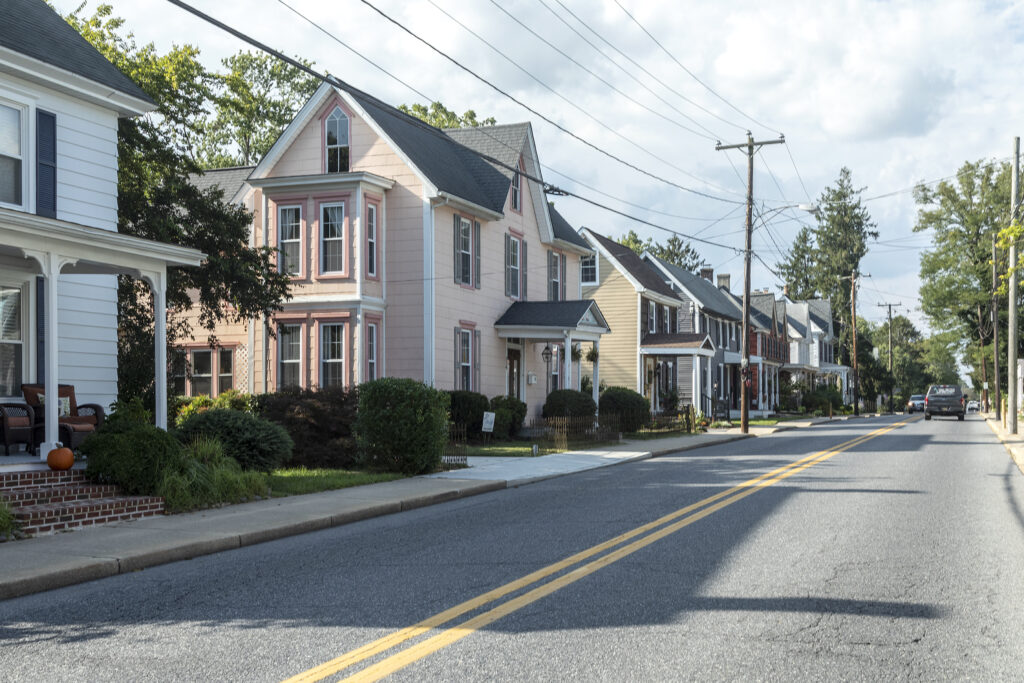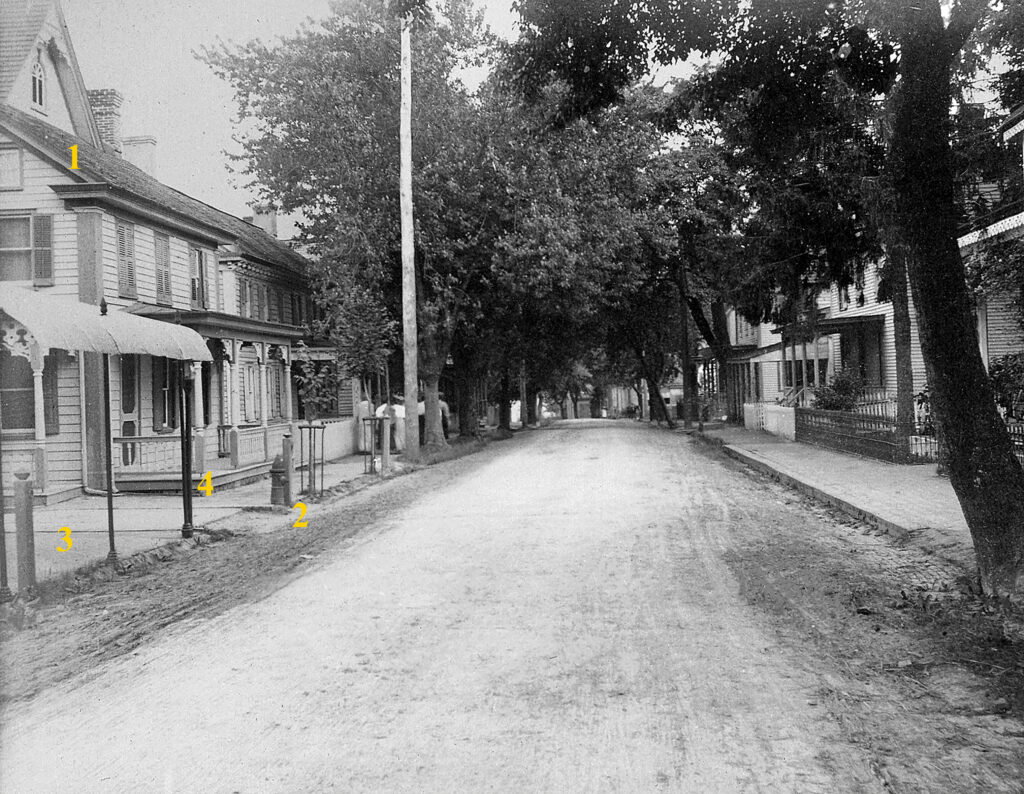The Milton Historical Society has a trove of photographs taken by Dr. William Douglas in the early years of the 20th century. By now, most readers of my blog posts will have encountered some examples of his work, a great many of which have become iconic. Some of Dr. Douglas’s street photographs, however, have had me scratching my head for years trying to determine where exactly they were shot. It is only after I started walking Union Street in preparation for an architectural tour that I started to notice details that I’ve previously missed.
Union Street Looking North

Just one detail in this picture is enough to determine its location, and I will get to that shortly. The photograph tells us a great deal more about the scene, however. Two things should jump right out at anyone looking at this who is familiar with Union Street today: the abundance of shade trees lining the street, practically forming a canopy over it in the far background; and the complete absence of cables dropping down to houses from utility poles. There are also no fire hydrants to be seen anywhere, although I’ve looked hard trying to spot one. Although I can’t say when the shade trees were cut down, the other two bits of information help date the photograph. Milton did not install a water system until 1916, and electric street lighting did not make its appearance here until mid-1907, although it may not have reached beyond the downtown area for years. This scene must have been shot between 1907 and 1916.
Now let’s take a look at some of the details:

- There is only one 2½ story building on the west side of Union Street with a two-story ell on its south side: the Capt. William Russell House at number 320. That part of the residence remains intact today. The front porch is different, however. Dr. Douglas’s photo shows a front porch that spans the length of the front side, with elaborate scrollwork; today, the house has a small porch in front of the entrance, with a pedimented gable roof.
- This house is today’s number 316; just to its left is the awning of a commercial building, William Riley Wilson’s general store for many years. The Wilson family lived in number 316 until about 1910.
- Union Street, as well as all the other streets in Milton, was unpaved until decades later. It was also widened at some point.
- Sidewalks were up to individual owners to lay down, and not the town’s responsibility. It is difficult to tell for sure, but it does not appear that any stretch of sidewalk along either side of the street is concrete.
- The two children standing in the street are broad brimmed straw hats and appear to be wearing nice clothes (the boy is wearing a tie). I’ll go out on a limb and guess that the picture was taken on a late Spring or Summer Sunday.
- There is a crude hitching post in front of number 318, and one further back, some distance behind the horse and buggy.
- This appears to be a gas street light, given its shape and low height (lamps had to be lit by someone).
- Drainage ditches were present on both sides of the street, with planks laid across them at intervals for the convenience of long-skirted ladies trying to get to their waiting carriage. During and after a heavy rain, the streets and sidewalks were one big mud flat; during very dry spells, they were a dust bowl.

Dr. Douglas shot another photo of Union Street from approximately the same location, this time looking south. This one had to have been made several years later, however.
Union Street Looking South

Dr. Douglas took another photograph of Union Street facing south (toward downtown and the Broadkill River). There are some notable differences between the north-facing and south-facing photos that indicate that the latter was shot several years after the former.

- There is one solid piece of evidence that indicates where Dr. Douglas shot this photograph – the Palladian window just to the upper left of the numeral 1. The only house on Union Street with a window like that is number 319. The three bay front with the entrance on the left side and the location of the chimney on the south side also match up to the appearance of the present day number 319. The full length porch, its scrollwork brackets and balustrade are gone, and there is a small addition on the north side of the home. On the neighboring house to the south, number 315, scrollwork brackets along the roof cornice are visible in the photograph and correspond to today’s appearance of that same house. A small group of men are standing in front of number 315, perhaps decrying the lack of progress on electric street lighting on this stretch of Union Street.
- The key indicator that this is a post-1916 photograph is the fire hydrant; the town’s water system and storm drains were built in 1916. Gone are the drainage ditches on both side of the street and the intermittent planks for crossing over them, The street is still unpaved.
- It appears that sidewalks have been laid down in front of most of the residences visible in this photograph.
- Difficult to discern but definitely there is a gas street light, quite possibly the same one that appears in the north-facing photograph. There is a utility pole clearly visible on the east side of the street, but there are no wires dropping from it nor are there any lights visible on it. I have to assume that electric street lighting hadn’t yet made it up Union Street this far in 1916-17. In fact, newspaper accounts of the day suggest that the utility companies contracted to provide electricity for Milton’s street lighting were underpowered during these years, and the town sometimes went dark.


Thanks, Phil. That was fun sleuthing!
Interesting idea to have a slide show with this theme.
bruce
That’s the thing about old photographs for me, especially street scenes – you can mine them forever.
I have photo of the area before the historical building . Also the bridge looking toward the church and Union St. Also a picture of my grandparents house at 209 Walnut if you’d like to see them.
Great work as usual! Much appreciated
Thanks so much! More on the same subject is coming shortly.
Phil thank you for this tidbit of information ,it’s nice to see the pics side by side and not the difference.
Conrad Welch
Always glad to here from one of my most consistent and supportive readers, Conrad! Photo forensics is one of my favorite activities.
Hi Phil, loved the photographs and information. My wife and I are the owners of 315 Union Street house and are very surprised how little our house has changed over the years. I just rebuilt the front porch exactly as it was last year and am happy to see it in these pictures almost exactly as it was when these photographs were taken..
Thanks for the feedback! I’ve been slowly figuring out what these old photographs are actually showing, and it’s always gratifying when homeowners respond.